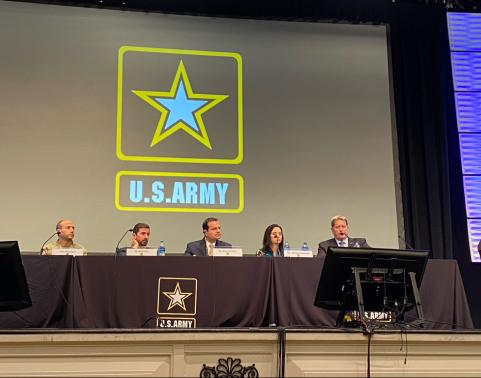PEO EIS discusses unified network support, Agile transition at TEM 9

PEO EIS Program Executive Officer Ross Guckert joined other Army leaders on a “Decision-Driven Data” panel at the U.S. Army Technical Exchange Meeting 9 (TEM 9) held Dec. 7-8 in Nashville, Tennessee.
Presented by the U.S. Army Network Cross-Functional Team and Program Executive Office Command, Control and Communications – Tactical (PEO C3T), TEM 9 focused on the Pacific and European theater of operations, including warfighter perspectives and lessons learned and applied for unified network and data-centric modernization priorities and experimentation.
Guckert’s presentation centered around EIS’ collaboration with other Army organizations to deliver the unified network, as well as EIS’ adoption of an Agile acquisition approach.
“At EIS, we’re reimagining how we modernize our posts, camps and stations,” said Guckert. “Not just a tech refresh with new routers, switches and fiber — but a strategy to deliver capability that aligns with zero trust principles that support multi-domain operations, Joint All-Domain Command and Control, synthetic training and other Department priorities. In so doing, we intend to reduce infrastructure and optimize wireless capabilities,” he added.
EIS is starting with the Army’s number one priority, Secret Internet Protocol Router (SIPR) network modernization, which is designed to modernize both the SIPR and Non-classified Internet Protocol Router network into one gray network that provides Soldiers with comprehensive, unified capabilities, including in disconnected environments.
Voice modernization is another focus area for EIS, said Guckert. That initiative involves taking phones off desks and reducing the Army’s overall hard phone count in time for the decommissioning of aging Time-Division Multiplexing infrastructure in fiscal year 2025.
EIS also is “moving out with ICAM” — or identity, control and access management — according to Guckert, who described it as “foundational to zero trust.”
EIS’ current ICAM solution leverages Enterprise Access Management Service – Army Multi-Factor Authentication and the Army’s Master Identity Directory to authenticate and authorize users, said Guckert, noting that the organization is accelerating Privileged Access Management in the next year.
As part of the Army’s Digital Transformation Strategy, EIS is working closely with PEO C3T to fully share operational strategic ICAM capabilities to allow for rapid capability fielding to tactical mission partners, enable zero trust and reduce costs. This will help inform the ICAM requirement under the Unified Network Operations Initial Capabilities Document, which will define the next-generation ICAM solution, building on the one that exists today, said Guckert.
To help deliver all of this capability faster, EIS is transitioning to a different software acquisition approach.
“This is the year of Agile; this is the year of acceleration,” said Guckert. “With the pivot to Agile and adoption of commercial best practices, we will deliver capability quicker, in an iterative fashion, with security baked in, streamlined testing, and — I would argue — better meet the needs of the customer.”
Industry can help EIS with its Agile transformation by engaging frequently with leaders to help them understand what best commercial technologies and practices are, and by putting a premium on innovation. Licensing cost models are another hot topic for EIS.
“We encourage industry to be flexible with their licensing cost models as we adopt Agile,” said Guckert. “We want to have a modular architecture, so that means a modular, open systems approach and not having perpetual licenses but a different approach and cost model.”
Upcoming procurement opportunities for industry are available on EIS’ website, said Guckert, noting that the SIPR Modernization request for proposal (RFP) will be on the street this month. Other upcoming solicitations include Pacific Modernization, Integrated Personnel and Pay System – Army Increment II, Release 4, and the Army’s holistic ICAM solution.
Besides Guckert, other participants in the TEM 9 Decision-Driven Data panel session included Jeff Witsken, director of mission command network integration at the Mission Command Center of Excellence; Jennifer Swanson, deputy assistant secretary of the Army for data, engineering and software at the Assistant Secretary of the Army for Acquisition, Logistics and Technology; Mark Kitz, program executive officer with PEO Intelligence, Electronic Warfare and Sensors; and Col. Matt Paul, project manager for mission command at PEO C3T.
Related News
-
Onedia James: a logistician and leader with a family legacy of service
April 22, 2025Onedia James recently stepped into the role of acting deputy project manager for Army Data and Analytics Platforms (ARDAP) at U.S. Army Program Executive Office (PEO) Enterprise, where she helps oversee and support the data portfolio’s four programs. -
PEO Enterprise’s new PL Digital Market reimagines IT product/service procurement
April 2, 2025FORT BELVOIR, Va. – U.S. Army Program Executive Office (PEO) Enterprise today announced the launch of the Product Lead (PL) Digital Market, which replaces PL Computer Hardware, Enterprise Software and Services (CHESS), effective Apr. 2, 2025. -
Two vastly different Army programs prepare for Software Acquisition Pathway
March 24, 2025At U.S. Army Program Executive Office Enterprise, which is now over two years into its Agile transformation, several enterprise software programs are already in the execution phase of the DOD’s Software Acquisition Pathway, which is designed to facilitate rapid and iterative delivery of software capability to users.
Work for Us
Join a winning team! Search for job opportunities with PEO Enterprise.
Work with Us
Help support important missions. Explore ways your company can work with PEO Enterprise.